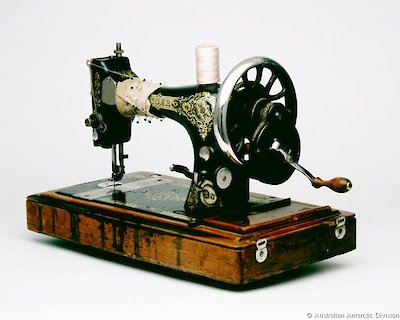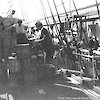A lot of hustle and bustle
In their own words
On leaving London there were of these Greenland, Esquimau sledging-dogs of which the purchase and selection had been made through the offices of the Danish Geographical Society. From Greenland they were taken to Copenhagen, and from thence transhipped to London, where Messrs. Spratt took charge of them at their dog-farm until the date of departure.
— Douglas Mawson, The Home of the Blizzard
Day by day, Johnnie Hunter and I rushed about the city in a hansom cab, from office to office, warehouse to warehouse, and from shipping company to wharf. During this time it was brought home to us the enormous amount of organization necessary to fit out a Polar expedition, and later, when actually in the South, and cut off from all civilization, we realized how complete that organization had been. Whether we needed a sewing machine or a tooth-pick, every want seems to have been anticipated.
— Charles Laseron, in South with Mawson: Reminiscences of the Australasian Antarctic Expedition, 1911–1914
Many of the Australian firms had been very generous with gifts of provisions and equipment, and it was our duty to take delivery of these and see them shipped … There were sledges and skis locally made from spotted gum and mountain ash. There were cases of bacon, tobacco, biscuits, hams and a hundred other sorts of provision.
— Charles Laseron, in South with Mawson: Reminiscences of the Australasian Antarctic Expedition, 1911–1914
As the time before departure contracted from months to weeks to days, the effort by Mawson and his growing band of men rose in inverse proportion. Mawson’s considerable organisational talents, and the skills and enthusiasm of his men, were taxed to the limit by the tight deadline and the need to ensure nothing was overlooked.
The AAE had to be totally self-contained. To feed the 56 members of the expedition on land and sea, the expedition used 23 tons of food to fuel the equivalent of 64 years’ work by one person.
Mawson found the most efficient way to obtain the wide range of materials required was to delegate the task to people most closely associated with eventual use of the items. To ensure they were familiar with often highly specialised equipment, the staff who were to operate it were involved in obtaining and shipping it.
A substantial quantity of goods — including rugs and blankets, sewing machines, gramophones, a piano, a library of books including science text, encyclopaedias and volumes of polar journeys and a typewriter — were donated or made available at or below cost.
When Aurora arrived in Hobart her hold was already crammed with 3,000 cases of equipment and stores. Another 500, including the air tractor, lay waiting in the wharfside warehouse in Hobart.


